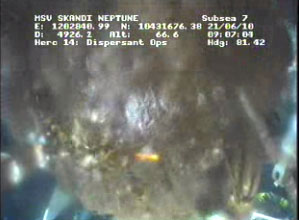While BP publicly stuck to claims that its blow-out well was leaking at rate of 5,000 gallons of oil per day, the company was privately operating under the assumption that at least five times that amount was gushing into the Gulf, according to documents released today by congressional investigators.
BP’s internal estimate of 53,000 barrels per day is buried in one of the company’s requests to use more than the maximum threshold of dispersants established by the EPA, which the Coast Guard released earlier this month. In letters dated July 6 and 11 to the government’s on-scene coordinator in the Gulf, at that time Coast Guard Admiral James Watson, BP Chief Operating Office Doug Suttles cited the 53,000 figure in justifying the company’s request to use 25,200 gallons of dispersant per day to break up the oil.
The official per-day estimate of the spill’s size is still a large range. The government’s flow rate team has said that during the three months that oil was spewing into the Gulf anywhere from 35,000 to 60,000 barrels may have leaked daily. But BP, after first claiming oil was entering the Gulf at a rate of 1,000 barrels per day and then later adopting the initial, extremely low government estimate of 5,000 barrels, hasn’t offered another estimate of its own in weeks.
The government team is expected to come up with a more concrete estimate, though there’s some concern that we’ll never get a truly accurate figure, which is crucial to levying fines against BP and assessing damages in the Gulf.
“In the case of BP’s financial liability and the flow rate of this spill, ambiguity is BP’s ally, and precision is the government’s,” said Rep. Ed Markey (D-Mass.), who chairs the Energy and Environment Subcommittee and the Select Committee on Energy Independence and Global Warming, which released the BP document. “This document turns the tables on BP by exposing their own assumptions about the size of the spill.”














